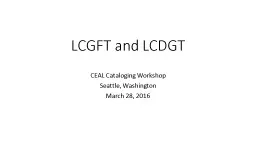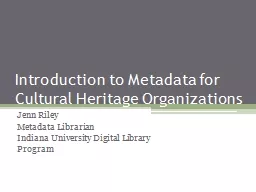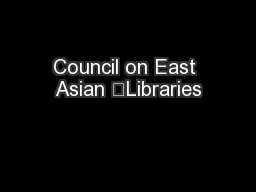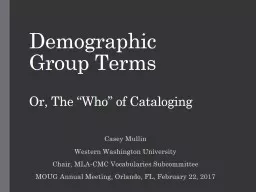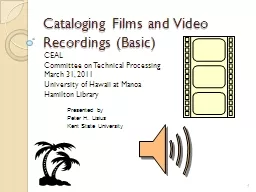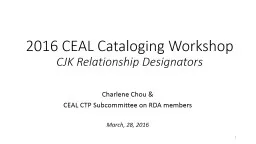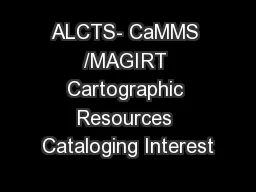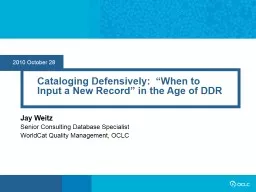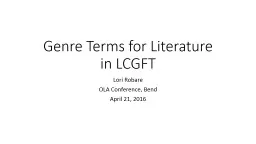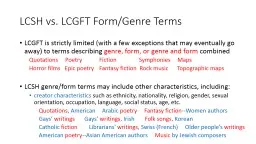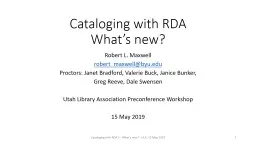PPT-LCGFT and LCDGT CEAL Cataloging Workshop
Author : alexa-scheidler | Published Date : 2019-06-26
Seattle Washington March 28 2016 Outline LCGFT General principles SACO Recent projects general music literature and religion terms Examples LCDGT MARC 385 and 386
Presentation Embed Code
Download Presentation
Download Presentation The PPT/PDF document "LCGFT and LCDGT CEAL Cataloging Workshop" is the property of its rightful owner. Permission is granted to download and print the materials on this website for personal, non-commercial use only, and to display it on your personal computer provided you do not modify the materials and that you retain all copyright notices contained in the materials. By downloading content from our website, you accept the terms of this agreement.
LCGFT and LCDGT CEAL Cataloging Workshop: Transcript
Seattle Washington March 28 2016 Outline LCGFT General principles SACO Recent projects general music literature and religion terms Examples LCDGT MARC 385 and 386 Where to find LCDGT. Emily Drabinski. Coordinator of Instruction. Long Island University, Brooklyn. @. edrabinski. emily.drabinski@liu.edu. Some of my axioms for talking about gender & sexuality. Socially constructed. Jenn Riley. Metadata Librarian. Indiana University Digital Library Program. Many definitions of metadata. “Data about data”. “Structured information about an information resource of any media type or format.” (. Possibilities for music discovery with LCGFT, LCMPT & other LC vocabularies. Nancy Lorimer. Stanford University. Music Library Association meeting, . Cincinnnati. 2016. Genre/Form & Medium of performance in LCSH. Annual Meeting. Plenary Meeting. March 14. Dominion . Ballroom South. Sheraton . Centre Toronto Hotel in Toronto, . Canada. Plenary I: Business Meeting. Agenda. Welcome. & . Recognitions. New . Or, The “Who” of . Cataloging. Casey Mullin. Western Washington University. Chair, MLA-CMC Vocabularies Subcommittee. MOUG Annual Meeting, Orlando, FL, February 22, 2017. Another thesaurus (?!?). CEAL. Committee on Technical Processing. March 31, 2011. University of Hawaii at . Manoa. Hamilton Library. 1. Presented by. Peter H. . Lisius. Kent State University. What Will Be Covered. Focus on DVD cataloging. CJK Relationship Designators. Charlene Chou &. CEAL CTP Subcommittee on RDA members. March, 28, 2016. 1. Agenda. Background. Issues to discuss. Type 1: Mixed roles. Type 2: Synonyms. Type 3: Not exactly equivalent to terms in the Appendix I. Group. ALA . Annual . • 2016 . June 26 . • . Orlando, Florida. Cataloging . Maps Defensively:. “. When to Input a New Record” in the Age of DDR. Jay Weitz. Senior Consulting Database Specialist. Connexion. Client. By Rebecca Bartlett. LACONI Technical Services Section Unconference. Elk Grove Village Public Library. September 21, 2018. La Grange Public Library. Member of SWAN Consortium of 97 libraries (18 OCLC cataloging libraries and 79 copy cataloging libraries). . Jay . Weitz. Senior Consulting Database Specialist. WorldCat. Quality Management, . OCLC. Cataloging Defensively: . Introduction. When to Input a New Record. OCLC Bibliographic Formats and Standards (BFAS), Chapter 4. in LCGFT. Lori Robare. OLA Conference, Bend. April 21, 2016. What we’ll cover. Brief background on . LCGFT. MARC coding for genre terms in bibliographic records. Genre terms for literature in LCGFT. LCSH vs. LCGFT Form/Genre Terms LCGFT is strictly limited (with a few exceptions that may eventually go away) to terms describing genre, form, or genre and form combined Quotations Poetry Fiction Symphonies Maps Library of Congress Faceted Vocabularies and the Contributions of the SAC Subcommittee on Genre/Form Implementation Adam L. Schiff Principal Cataloger, University of Washington Libraries aschiff@uw.edu Robert L. Maxwell. robert_maxwell@byu.edu. Proctors: Janet Bradford, Valerie Buck, Janice Bunker, . Greg Reeve, Dale Swensen. Utah Library Association Preconference Workshop. 15 May 2019. Cataloging with RDA 2 - What's new? - ULA, 15 May 2019.
Download Document
Here is the link to download the presentation.
"LCGFT and LCDGT CEAL Cataloging Workshop"The content belongs to its owner. You may download and print it for personal use, without modification, and keep all copyright notices. By downloading, you agree to these terms.
Related Documents

